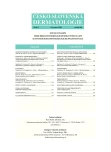Miliaria Pustulosa
Authors:
N. Tancurinová 1; I. Žampachová 1; L. Pock 2
Authors‘ workplace:
Východočeské dermatologické centrum Homea, spol. s. r. o.
1; Dermatohistopatologická laboratoř, Praha
2
Published in:
Čes-slov Derm, 86, 2011, No. 3, p. 148-152
Category:
Case Reports
Overview
Miliaria is a common disorder of the eccrine sweat glands often occuring due to increased heat and humidity. Miliaria are caused by the blockage of the sweat ducts leading to the leakage of eccrine sweat into the epidermis and dermis. Three types of miliaria are recognized, each reflecting obstruction of sweat ducts at different levels: miliaria crystallina, miliaria rubra and its variant miliaria pustulosa, miliaria profunda. We describe a case of 34-year-old male with miliaria pustulosa.
Key words:
miliaria – eccrine sweat glands – miliaria crystallina – miliaria rubra – miliaria pustulosa – miliaria profunda
Sources
1. ARENBERGER, P., OBSTOVÁ, I. Obecná dermatovenerologie. 1. vydání. Praha: Czechopress Agency, 2001, s. 15, ISBN 80-902632-4-0.
2. BOLOGNA, J. L., JORIZZO , J. L., RAPINI, R. P. Dermatology. Second edition. New York: Mosby, 2008, p. 540–544, ISBN 9781416029991.
3. BRAUN-FALCO, O., PLEWIG, G., WOLFF, H. H. Dermatológia a venerológia. 1. slov. a české vyd. Martin: Osveta, 2001, s. 901–902, ISBN 80-8063-080-1.
4. HAAS, N., MARTENS, F., HENZ, B. M. Miliaria crystallina in an intensive care setting. Clin. Exp. Derm., 2004, 29, p. 32–34.
5. KIRK, J. F., WILSON, B. B., CHUN, W., COOPER, P. H. Miliaria profunda. J. Am. Acad. Dermatol., 1996, 35, 5, p. 854–856.
6. NANDA, S., REDDY, B. S. N., RAMJI, S., PANDHI, D. Analytical study of pustular eruptions in neonates. Pediatric Dermatology, 2002, 19, 3, p. 210–215.
7. ŠTORK, J. et al. Dermatovenerologie. 1. vydání, Praha: Galén Karolinum, 2008, s. 10, ISBN 978-80-7262-371-6.
8. TABANELLI, M., PASSARINI, B., LIGUORI, R. Erythematous papules on the parasternal region in a 76-year-old man. Clin. Exp. Derm., 2008, 33, p. 369–370.
9. URBATSCH, A., PALLER, A. S. Pustular miliaria rubra: A specific cutaneous finding of type I pseudohypoaldosteronism. Pediatric Dermatology, 2002, 19, 4, p. 317–319.
10. WENZEL, F. G., HORN, T. D. Continuing medical education: Nonneoplastic disorders of the eccrine glands. J. Am. Acad. Dermatol., 1998, 38, 1, p. 1–17.
Labels
Dermatology & STDs Paediatric dermatology & STDsArticle was published in
Czech-Slovak Dermatology

2011 Issue 3
Most read in this issue
- Pityriasis Rubra Pilaris
- Miliaria Pustulosa
- The Significance of Diagnostic Hypoallergenic Diet in Patients with Atopic Eczema
- Follow-up of Patients with Melanoma
